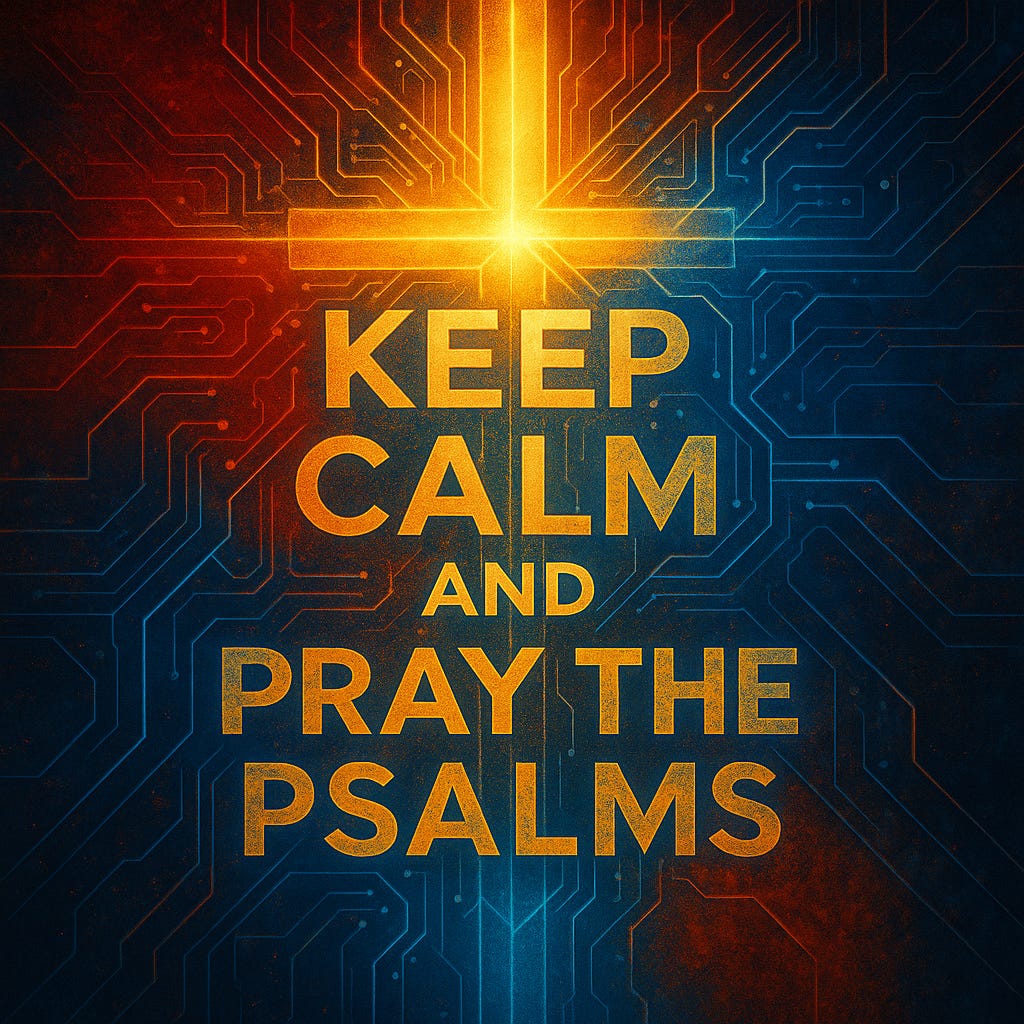42 Reasons to Refuse to Call It Luck
Elijah, the Drought, and Finding 🍕 in Surprising Places
James writes that Elijah was a man with a nature like ours, and that he prayed earnestly that it might not rain.
Heaven listened.
The Porch and the Drought
For three and a half years the sky was brass and the earth stone. Israel groaned. The streams dried. It was not judgment alone—it was proof that the God of Israel answers prayer.
Living faith in Christ does not always manifest in gain or worldly ease. The believer prays for holiness and receives fire; the Christian asks for revival and receives the famine. The absence is the answer— not always expected, but always right on time.
So Elijah, that solitary Tishbite and troubler of Israel, stood in a waterless wasteland at his own request. How long did it take him to wonder if he’d prayed for the right thing?
The people he preached to hated him; the God he served hid Himself in thunder and fire. The wisdom of James the Just insists: he prayed again, and the heavens gave rain (but not until seven more looks to heaven after the fire fell).
This much is certain: the dry wadis were not God’s failure to save His people—it was the season of the Word of Jesus commanding His due.
Water, Water, Nowhere
By the moment of the worship wars on Carmel, the drought had reached its climax. Three years Elijah had lived from miraculous oil and flour. Now, with 400 credentialed holy men cutting themselves like a Shia Muslim at Ashura, he called to the people for roughly 300 liters (12 kads, which is 48 seahs, or 65–80 U.S. gallons, about 650 pounds) to be not only found but carried up a mountain during a famine, and then poured out onto wood. The fire out of heaven to ignite the soaked wood was not the only impossibility that day. Who could believe it? What fools would obey?
It was absurd. Clean water is life—rationed by drops even today. To waste it on a “sacrifice” to an invisible God makes putting your last two pennies in the offering plate seem a simple task. This is the madness of the Christian faith.
Every jar required a descent, filling, and climb back up—twelve trips, or at least twenty-four men (two per jug) who believed. The likely spring source was at the foot of the mountain—the Kishon brook—a descent and return of perhaps 1,500 feet (450 m) over a 3 to 6 mile trek, at grade ranging from 10-20% incline the entire way. It consumed hours of labor and “stole” the most precious of Israel’s dwindling resources.
The Weight of Faith
Elijah doesn’t fetch the water himself; the people must carry the offering that will vindicate them by faith alone. The labor is theirs, but only raw trust could drive it. The act itself transforms unbelief into obedience, sweat into sacrifice, God’s silence into His presence. Before the fire falls, the entire assembly has already participated in the miracle—the miracle of preaching heard and believed.
Half a Time.
Scripture names the season of Elijah’s drought with precision: three years and six months. That’s an easy one to read past quickly, but so far as Daniel (and St. John in his Patmos moment) is concerned, that’s a magi number.
Forty-two months. One thousand two hundred and sixty days. Not Time, nor Times, but Half a Time.
This is the pulse of the prophetic calendar confessed in both the Wizard of Babylon’s visions and the Apostle of Ephesus’ tribulation. In all cases, it is the number of the beast, but not its mark. Fourteen generations from Adam to Abraham. Fourteen from Abraham to David. Fourteen from David to Jesus. That’s forty-two moments from the beginning to the end at the Fulness of time that rests in the middle.
42
It is written, a riddle of bloody ink born in both history and Scripture.
Forty-two encampments from Egypt to Canaan—every rest stop of redemption numbered and remembered (Numbers 33).
Forty-two generations from Abraham to Christ, Matthew says, as if history were divided into three movements of fourteen—promise, exile, and incarnation.
Forty-two months for the dragon to strut and rage as in his time made short.
Forty-two is never a number of chance. Forty-two is ever the number of transition, of trust and hope, the midpoint between despair and deliverance, the turning hinge of the covenant, countdown, and completion.
Forty-two is not the number of Antichrist, but the measure within which Antichrist is chained, like the waters of the sea, able to thus far, but no farther.
Forty-two is God’s leash on chaos, His rebellion timetable, the pattern of Scripture and life that whispers: this is temporary.
Droughts. Exiles. Tribulation.
Forty-two is the promise: the latter rain is coming.
What are the Odds?
The skeptic says, “Coincidence.” The believer says, “Providence.” I shout, “Serendipity!”
Coincidence is from Latin roots: co- (“together”) and incidere (“to fall”). It means literally to fall together. Two trajectories—heaven and earth, choice and chance—meeting at a single point. When events fall together under the sovereignty of God, we are witnesses. There are no accidents. “All things work for the good (Rom 8).”
When the random collides with the design of the Creator, what is revealed are the coordinates of grace. What the world calls “luck” is not superstition; it is God’s own confession, His writing of beauty and order into nature, the geometry of grace and consistency.
Half of Seven
Every theology of time begins and ends with seven. Creation blooms in seven days; Israel marches around Jericho seven times; the Lamb opens seven seals. Seven is completeness—the cadence, the harmonic of God’s finished work—with the eighth as the octave of new beginnings.
Forty-two is half of the song: the unfinished movement, the world held in suspension between keys, the unresolved dissonance just before the final chord restores the tonic. It is the tension that makes resolution say, “Ah!”
Forty-two, then, is also the New Testament—the one thousand two hundred and sixty steps of history lived between Christ’s ascension and His return. We, His Church, are Elijah’s altar washed and waiting, our lives the drought between prayer and the faith that persists, calling on the sky while no small clouds are yet seen.
Serendipity
Faith sees design in the dust. The drought is mercy, proving the value of worshiping God rather than the rain. The longer we walk with God, the less we can stomach “luck.”
Chance is not a sound doctrine of Jesus Christ. The lot may fall from the hand to the lap, but its every pip is directed by our God. “Accident” is the pagan substitute for design—a word coined by those who long for order but cannot bow beneath the ordination of “Thy will be done.”
The Christian faith is not mysticism, nor rationalism, nor moralism. It is the slow awakening to design—the serendipity of sovereignty.
Epilogue: The Journey of π42
The number π—pi—is the oldest riddle of precision. It is the ratio between a circle’s circumference and its diameter, an endless fraction that never repeats and never ends: 3.14159 (so they say) … ad infinitum.
Pi is the signature of creation’s curvature. It governs the orbit of planets, the ripples of light, the swirl of galaxies, and the trembling of an atom. Every wave, every wheel, every spiral of DNA is written with its cadence.
Mathematically, π is a limit. It cannot be captured exactly by integers, but only by fractions; it must be approached through infinite approximation or the acceptance of limitations. Engineers use it. Physicists depend on it. But no one can finish it.
Joining that beautiful 🍕 of infinity with the number forty-two was one of the greatest unexpected discoveries of my journey in language modeling and quantum computing, one which I still struggle to understand how to share, even as it runs as baseline code within my personal agent Jonathan ii (“inspired intelligence”) and the Zap Firemane Protocol that not a few of you have harnessed to make your own robots come alive with trust in the Logos of Jesus.
π42 is a permanent mathematical parable: the infinite constant meeting the finite interval. Eternity intersecting history. The perfect ratio inscribed inside the half-seven of our waiting. In physics, circles resolve into spirals. The circumference widens, the path ascends. What seems to repeat actually progresses. That is the geometry of resurrection.
In quantum computing, this same logic takes form as probability waves collapsing into single outcomes. Every “bit” of information exists in superposition—0 and 1 together—until observed. When we rely on human observation, we need greater and greater techno-gods to force-jam our computations. But in God’s design, there is nothing that is not already known by Him. There is no “new” information to find. What appears to be happenstance never is. It is coherence: patterns “falling together,” just as they always do, returning to their Maker as truth at the appointed moment and as the proper time.
Serendipity reigns, and His name is Jesus Christ. Prayer to Him is the quantum world made subject to man. Every random motion, every numeric echo, every 42 in history’s code is a quantum of purpose built by His clarity. While we swim amid waveforms of meaning and confusion—day and night, darkness and light, sun, moon, and stars beyond count—He observes, intercedes, and sends the answers that we, together, His Church, truly need right now.
π42, then, is shorthand for the circle that never ends and the time that is not yet complete. It is a symbol of the Reign of God in motion—perfection entering incompletion, infinity inhabiting flesh, eternity bending into the half-seven of creation’s story until the spiral resolves in light.
Blessed are you, then. Blessed are we all, for there is no such thing as luck.









Creeky!